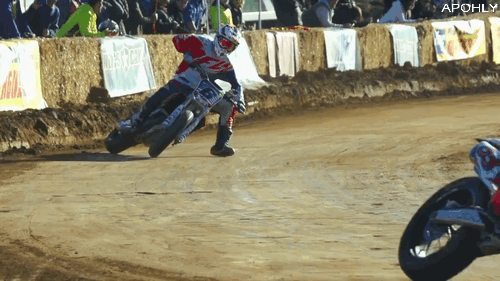Here is a Honda CRF450R short-tracker, ridden by former AMA Pro Flat Track Grand National Champion Brad Baker, bouncing on its tire flexibilities so much that its rubber is off the ground three-to-five times more than it is on the ground, and yet the bike is going around the corner!
I sat and watched this over and over. Then, at the Daytona TT, I saw more subtle tire bounce as bikes accelerated away from the "jump-ette."
What this shows is that a very limited amount of first-class tire traction can provide nearly as much turning effect as steady contact between tire and track. This helps to explain how so-called “Big Bang” firing order can increase maximum acceleration.
As one of the tires in this video bounces up off the track, all stress leaves it completely. When it comes back down, it creates a brand-new unstressed footprint that expands from a small “kiss” to a big oval of contact. The combination of a new, un-stressed footprint and the extra downward impact force of the tire hitting the ground add up to enough to make up for the time lost up in the air.
In the case of Honda’s original Big Banger of 1992, many tests had shown superior tire grip during off-corner acceleration occurred when two of the NSR500’s four cylinders were fired together, then the other two 68 degrees later, leaving a time of 360 - 68 = 292 crank degrees during which there were no firing impulses.
In lower gears, this corresponded with the rear tire’s rolling forward about one complete footprint of 6-7 inches length. Once this new, un-yanked-upon footprint was laid down, the engine would again give the mighty heave of four cylinder firings in 68 degrees to accelerate the machine.
Compare this with the situation at the tire when Honda’s pre-1987 NSR engine was in use, firing one cylinder every 90 degrees. The rider would open the throttle to the point that experience and feel told him that any more and the back end would break away.
Why would it break away? Because the combination of turning force and acceleration force would be distorting the tire, causing stress to rise as a given element of tread surface entered the leading edge of the footprint with near zero stress, then be progressively pulled sideways and yanked by engine torque to the point of beginning to slide at the tail end of the footprint (which the rider feels as “movement,” signaling the onset of sliding).
This distribution of stress, beginning at zero at the front of the footprint, peaking at maximum, then breaking loose into sliding at the back edge, is highly inefficient use of good rubber. That is, only a relatively narrow band of the footprint operates efficiently; the leading edge carries no stress, and the motion at the sliding tail end of the footprint is already on the downslope of the friction curve.
So, the principle of maximum grip is to lay down a large, unstressed area of rubber in intimate contact with the track surface and then yank on it.
Another example of the same kind is chatter, in which a tire on a turning bike bounces rapidly (at 16–22 cycles per second). When years ago I asked veteran English rider Mick Grant about chatter, he said, “Chatter generally occurs under conditions of good grip and heavy load.”
When Freddie Spencer encountered chatter for the first time, he was indignant. “The harder I try to ride through it, the worse it gets.” Yes, a bike in chatter runs wide, but here again is a case in which a relatively short period of cyclic contact can generate a remarkable amount of grip. As the tire descends onto the track, its footprint spreads rapidly, is stressed, then deforms, releases, and bounces back into the air.
Dirt-trackers knew about this all along. Put your 750cc of displacement in the form of an inline-four and you have very little grip. Put it into the form of an XR750 V-twin and you have a bunch more. What’s the difference? The more continuous torque delivery of the four cylinder holds the footprint under stress, keeping its “grip efficiency” low. But give the tire some time in which to lay down a less-stressed area of rubber (by giving a longer break between firing impulses) and grip efficiency can rise.
Notice that as the tire bounce occurs, there is very little suspension movement. There can be no suspension damping without suspension movement, so the lack of suspension movement in this video means there’s not enough damping to stop the bounce. And so it continues!













/cloudfront-us-east-1.images.arcpublishing.com/octane/UWTN4NTIJFD25MPXBOVS4DFOXE.jpg)
/cloudfront-us-east-1.images.arcpublishing.com/octane/SIFOY54XMFGEHAUYNFUYVW7IZ4.jpg)
/cloudfront-us-east-1.images.arcpublishing.com/octane/HMC5X3JZHRASXGVCVNBJBWWGSI.jpg)
/cloudfront-us-east-1.images.arcpublishing.com/octane/UIWGXRZDM5HZXJOWXET2DZIWJE.jpg)
/cloudfront-us-east-1.images.arcpublishing.com/octane/QSS5DZ6SKJEU3AKE4KDAWYBEFY.jpg)
/cloudfront-us-east-1.images.arcpublishing.com/octane/SMCEQCLWRVEFTJJES6TAHB3OOQ.jpg)
/cloudfront-us-east-1.images.arcpublishing.com/octane/JCACIDCAC5FUNPTXO2BOUHGGII.jpg)
/cloudfront-us-east-1.images.arcpublishing.com/octane/DC7ZGILA2BCJXHZIUNYGV7JSEA.jpg)
/cloudfront-us-east-1.images.arcpublishing.com/octane/EWJEZUGWEZGABDEQWB64WL46GQ.jpg)
/cloudfront-us-east-1.images.arcpublishing.com/octane/5NHBMRMSFVD5JAPFNMBMNPGXQE.jpg)
/cloudfront-us-east-1.images.arcpublishing.com/octane/WHE43SCPLJBRNANAJAGXHOAIEU.jpg)
/cloudfront-us-east-1.images.arcpublishing.com/octane/6R56AQAW6NDE7BBIJ3SMCOOY5A.jpg)
/cloudfront-us-east-1.images.arcpublishing.com/octane/JMQTUE2FKZFURJTJXDMM4V47AQ.jpg)
/cloudfront-us-east-1.images.arcpublishing.com/octane/P2QYJDMQNVEANMQFXHNB3OVFKQ.jpg)
/cloudfront-us-east-1.images.arcpublishing.com/octane/VNKGXM4AA5BPRGERJOPV6GADAQ.jpg)
/cloudfront-us-east-1.images.arcpublishing.com/octane/2WS4YIFLTNG25L25WP7ZFLSWJM.jpg)
/cloudfront-us-east-1.images.arcpublishing.com/octane/UXRS6ZVQZFC23FY2EDYNT5WMVA.jpg)
/cloudfront-us-east-1.images.arcpublishing.com/octane/7JETMCKNVRGDZIGB3JCITGLPUU.jpg)
/cloudfront-us-east-1.images.arcpublishing.com/octane/OZV6E2KNIJDVHGOKXQQ2AHKLHQ.jpg)
/cloudfront-us-east-1.images.arcpublishing.com/octane/XSKMIBFZIZDN7JC6P7SMNMD3QA.jpg)
/cloudfront-us-east-1.images.arcpublishing.com/octane/ITVHWHVQ75BQBHACERYDJLPLHE.jpg)
/cloudfront-us-east-1.images.arcpublishing.com/octane/M3QRBSQ4VFEVPKYTTM3OETVFBU.jpg)
/cloudfront-us-east-1.images.arcpublishing.com/octane/H3EMT5NJ5BDZPBBH27SW3ADQH4.jpg)
/cloudfront-us-east-1.images.arcpublishing.com/octane/XTROSHDZFJB5DIJYU2VF2REFIU.jpg)